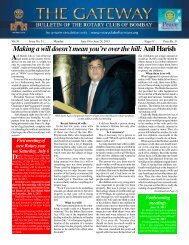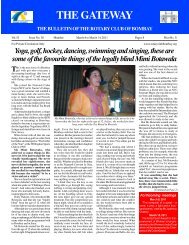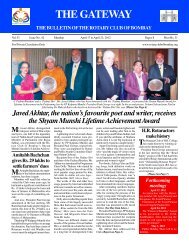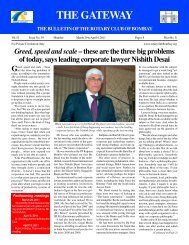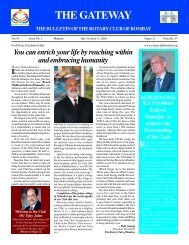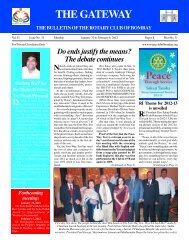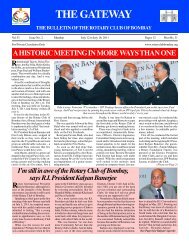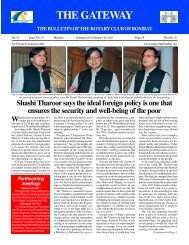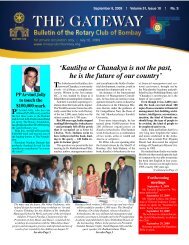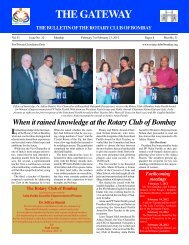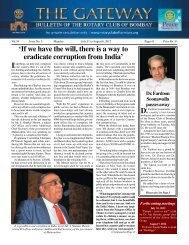Create successful ePaper yourself
Turn your PDF publications into a flip-book with our unique Google optimized e-Paper software.
‘NOT ONLY POLICE, EVEN THE PUBLIC BELIEVESTHAT CCTV CAMERAS ARE A VERY POWERFUL TOOL’(Continued from Page 2)India, on the other hand, with 20%of the world population, had a CCTVcamera density that was not worthwriting home about.“But how did a small country likethe UK come to possess so many cameras?It was actually an accident, likemany things that happen in the UK...”The first time that a camera caughtcrime in the course of public spacesurveillance in the UK was in Scotlandin the days of light-sensitivepaper that required hours if not daysto develop a photograph. One picturehad caught someone stealing ahandbag. Things got going only in the1970s.As the consumption of alcoholincreased on Friday and Saturdaynights, there was behaviour of thetype not normally seen in decentLondon with its huge African Caribbeanpopulation.CCTV images taken in Brixton andshown on the news helped nab theman even as he was planting a bomb.The public soon started to believethat CCTVs were quite a powerfultool<strong>Of</strong> course, there were those whohad problems such as people workingfor civil liberties and so on. Butall of them were forced to hold theirfire because the new tool was cominginto vogue at a time when the countrywas dealing with Irish terrorism.“The word terrorism is often usedto stifle public debate – and I wouldsay that as a counter-terrorism officer.Terrorism is an awful thing andno one knows that better than theresidents of Mumbai, but it shouldn’tbe used as something that stifles publicthe cameras that seem to be everywhere.“A lot of it is farmed out to theprivate sector, which again creates aproblem when we try to ‘harvest’ theimages, or to find the cameras, becausethe private sector is not regulated;it goes about changing cameras,moving them or taking them downwithout informing us. Every timesomething happens, we have to goout afresh and identify where thecameras are, who owns them andwhere the images are being stored.”Mr. Goodwin claimed that the generalpublic in the UK was not worriedabout CCTV. It believed that ifone had nothing to hide, then therewas nothing to worry. But the publiconly looked at things in black andwhite; it never mulled over or debatedissues in detail.some inappropriate behaviour, wasgoing on.The authorities had stepped in recentlyand camera operators werenow being regulated. They had tohave a certification in order to dopublic space surveillance.Mr. Goodwin next referred toANPR or Automatic Number PlateRecognition which was being usedwith increasing frequency. It automaticallypicked out the registrationplates on cars and checked themagainst police and other data bases. Ifan agency had any concerns, it couldask the CCTV providers with ANPRto look for certain cars. Although thissystem was invented in 1976, the firstarrest of a person driving a stolen carwas recorded in 1981 in Dartford inKent.And now, after wasting a lot ofsocieties. Such anti-socialdebate about some very serious Since the police did not monitor time, money and energy, the Met-behaviour was becoming a problemin the cities and, when combinedwith other crimes such asthefts from cars, burglaries and soon, someone thought about installingcameras so that the revellerscould be monitored.When the Home <strong>Of</strong>fice made grantsavailable to local authorities to suggestsolutions, they came up withsome very good business cases. Suddenly,CCTV systems financed bythe Home <strong>Of</strong>fice were springing upall over the UK.However, they made an impactonly in 1993 following the murder ofa two-year-old boy, Jamie Bolger,who was with his mother in a shoppingcentre in the north of England.Two ten-year-old boys managed tolead him away when his motherwasn’t paying attention. The CCTVfootage showed one of the boys leadingJamie by the hand out of the shoppingcentre.Mr. Goodwin said that the boyswent on to murder the child on a railwaytrack. The CCTV images wereforced on the public consciousnessand led to the capture and prosecutionof the two boys.There were a few other cases, too,such as that of David Copeland whowas “a loner, a right-wing extremistwho hated everybody who was differentissues.“What many people don’trealise is that of all the cameras,very few are controlled by the policethemselves. Even in the secureareas of London where theseats of governance are located,there are very few cameras monitoredby the police. They are monitoredby private industry and localauthorities... we ourselvesdon’t have the people to monitorthe cameras, it had no control overthem or over the individuals sitting inrooms and monitoring them whileworking for private companies. A recentuniversity study had shown thatsome of these individuals spent theirtime looking at inappropriate things.Those most likely to be zoomedin and filmed were attractive womenand coloured people of both genders.There were some issues involved inthis and some discrimination, as alsoropolitan Police had finally concludedthat if it wanted effectivesystems, it had to get people whoknew what they were doing andwho could devote their energiesto think of solutions and the bestways to implement them. The policehad finally started using privateindustry.“I have here (in the audience) acolleague from the Olive Group (Mr.David Samwell) which records all thetraffic going into London throughANPR systems; it’s an incrediblyeffective tool and was brought in aftera considerable spate of bombingsby the IRA. If the police use industry,then you can really get thingsgoing.“Some of the issues that I talkedabout, about the cameras being everywhereand not being regulated... ifyou use industry properly and givethem a tight brief of what you aretrying to achieve, you can workagainst those issues and make surethat you are using your cameras forthe purpose you have in mind.“We are now sitting down and talkingto the community. We don’t haveall the answers... we tell them thatwe can give you a police state, butwe’re sure you don’t want that. Sowhat are the levels that society willtolerate? We have to find out.”from himself”; he carried out a In spite of the plethora of cameras in the UK, very few are controlled by the Mr. Goodwin then took a light digseries of attacks, in Bricklane in the police themselves. Even in the secure areas of London where the seats of at the traffic situation in <strong>Bombay</strong> andeast end of London (a predominantly governance are located, there are very few cameras monitored by the suggested the introduction of laneAsian area), in a Soho bar for gay police. They are monitored by private industry and local authorities, discipline as in London. “Whypeople and in Brixton in the south ofreveals Mr. Stuart Goodwindoesn’t somebody paint white linesAugust 10 to August 16, 2010 THE GATEWAY, The Bulletin of the <strong>Rotary</strong> <strong>Club</strong> of <strong>Bombay</strong> Page 6



